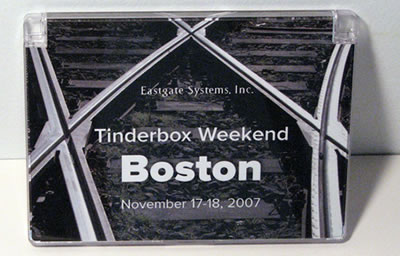Everyone's Everyday Work is Hard

Tinderbox Weekend Boston is focusing on Tinderbox for writers and writing. We're having a great time — and the plot continues to turn in unexpected directions.
Bill Bly (We Descend) opened the curtain on Tinderbox for managing a writing life, where the challenges are not necessarily what you'd expect. Yes, there's the matter of tracking what you've got finished and where you're trying to sell the manuscript — the inevitable freelance tangle of hope and commitment. But even more challenging, you've got many open projects — was that four or five projected novels we saw in one map? — and you've got lots of moving parts, including 1000 words of morning writing every day, not to mention jottings in your notebook. That adds up to hundreds or thousands of valuable, expensive things that you could easily lose or neglect; it's a lot of work.
I talk a bit about new developments in Tinderbox: better maps (and why better maps matter), richer actions, better connections to the Web and to outside programs. We spent a good deal of time discussing set attributes, and how they express multi-valued relationships.
John M. Stephan gave us a lovely look at two complex problems. First, he showed us how he can use Tinderbox to keep track of all the people involved in the sort of complex litigation he practices. Building large, comprehensive and searchable maps of all the names that arise in an investigation provides a terrific resource for understanding just what's going on, and what the opposition might be trying to do. Then, he turned to Tinderbox for world building — in this case quite literally: a Tinderbox design study for his new kitchen. This grew out of a very simple list of Things That Need To Go Into The New Kitchen, and became a rich master plan of where everything would be stored, where it would find the water or power it requires, and where the other tools or implements with which it is used will be found. The margins of the map also provide a good place to explore alternatives and to record paths not taken.
Finally, Sarah Smith explored Tinderbox for World Building — for planning and plotting all the information needed for her richly-detailed historical novels, and also for working out the relationships among metaphors and themes. As a working example, she described a fascinating project that threads its way between the Black community of 1912 Manhattan and the Titanic, and the challenges of handling iconic scenes and events. Not to mention characters who require frequent discipline, because "if you really let them do what they want, they'd pick up and move to Brazil."
Now, we're munching warm bagels and preparing to hear Matt Griffin's account of using Tinderbox in screenwriting — including a feature film in Sicily where he was using Tinderbox each night to rewrite scripts for the next day's shooting.